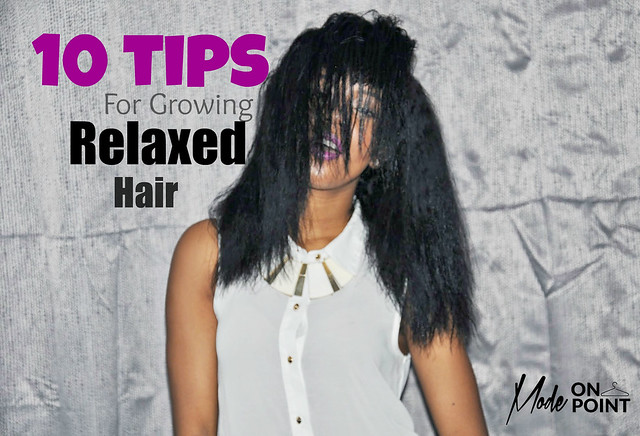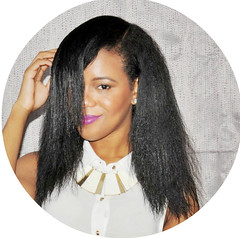
There are so many myths around relaxed hair and its ability to grow and maintain its healthiness. Relaxed hair can grow just a quick and long as natural hair. Maintenance is key in growing any hair type long and healthy. Below are 10 tips I use to grow my relaxed hair!
1. Develop a regimen that works for you
There are so many hair care regimens on the internet to inspire you, however, since everyone's hair is different, it's important to start by assessing your own hair type to see what works for you. Hair regimens involve an outline of how and when to wash, moisturize, treat, trim and relax your hair. There are two questions I asked myself when drafting out my personal hair regimen; how much time do I have to dedicate to my hair? and what products should I use?
Timing is everything because you want to be able to have a hair care regimen that fits with your current schedule and lifestyle. That way you can ensure sticking to it and seeing success. The problem many people make starting off is having a hair care regimes that completely disrupts their lifestyles and becomes too much a focus of their daily life. You want a regime that is just as routine as brushing your teeth at night before bed - simple and thoughtless.
Testing various products is one of the ways of finding out what works for your hair type. If you find something that works, stick to it. It's great to experiment and try new products, but keep in mind that just because something works for your best friend Sally, that doesn't mean it's going to work for you too. So if you find a brand that you trust and love, then by all means- stick to it!
2. Moisture is key
Using moisturizing products is probably the main ingredient in my hair care regimen. It's very important that my hair is adequately moisturized on a daily basis, moreover, now that the air is getting colder and drier. A well moisturized hair helps prevent split ends, shedding and tangling. I thoroughly moisturize my hair after washing and would normally re-moisturize it several times per week depending on how dry it gets. I have noticed that the ends of my hair tend to get dry faster, so I'll be sure to re-moisturize the ends 2-3 days following the initial moisturizing step.
3. Don't forget to seal in that moisture
Moisturizing your hair is one thing but sealing in that moisture helps it to last and lock it in. I love using a natural oil like coconut oil or Olive oil to seal in my moisturizer- just make sure it's organic.
4. Develop and stick to a wash and treatment routine
As part of my hair regimen, I have a systematic outline of how often I wash my hair and navigate my treatment sessions. It's ideal to do keratin and moisturizing treatments once per month. Keratin treatments add back the keratin lost through chemical or heat processing while the moisturizing treatment adds back moisture to the hair. Once I do a keratin or moisturizing treatment, I normally wait 2 weeks before I do the other.
5. Condition 2x more than Shampoo
Relaxed hair tends to lack moisture, so it's important to condition way more than you shampoo. For most people, this is where co-washing comes in. Co-washing involves using conditioner only to cleanse the hair. I normally do a co-wash every midweek. This process also helps to add in some moisture lost to the cold weather.
6. Extend relax sessions and relax with care
It is so easy to damage healthy hair from over processing with relaxer. Normally, it is stated to relax your hair every 3-4 weeks, however I personally think that is way too soon between each relaxer session. I normally go 4-6 months before another relaxer. I also like to "touch-up" my hairline in between sessions.This helps me to retain the density and thickness of my hair and prevents over processing and damage.
7. Get your hair trimmed regularly
Yes! you've heard it many times, "if you want your hair to grow then you have to trim it often". It may sound a bit counterproductive, however, getting rid of those split and dead ends soon before they transfer further up the hair shaft helps. I try to do a trim every 4 weeks.
8. Reduce Heat Use
Our favorite hot tools are not our best friends gals and pals. It's important to use a heat protectant before using any heated tool onto your hair. It is just as important to reduce the amount of heat you put on your hair. If you can skip the blow drying process, then do. I like to let my hair air dry, however, on days where I'm feeling less than patient I'll dry my hair 70% with the blow dryer and air dry the rest. If blow drying and flat ironing is an absolute must, try only doing it once per week.
9. Wear Gentle Styles
I try not to wear styles that put tension on my hair that would cause breakage. I also wear protective stylings very often. This includes my personality u-parts, ponytail and buns. When it comes to hair weaves, I avoid doing sew-ins because they cause a lot of damage and breakage. It's more challenging to maintain a hair regimen with a sew-in, however with a u-part, you can removed the unit easily to wash and moisturize your hair. Point is, it's your hair and you should have fun with it.
10. Its a wrap
Wrapping your hair at night helps to reduce breakage that can cause from friction while you sleep. Using a silk head wrap helps to keep the moisture from transferring from your hair and onto your pillow and face. Its also an ideal way of maintaining straight hairstyles throughout the week and diminishing the number of times you'll need to use a flat-iron. So put that head scarf on girl!



Post a Comment